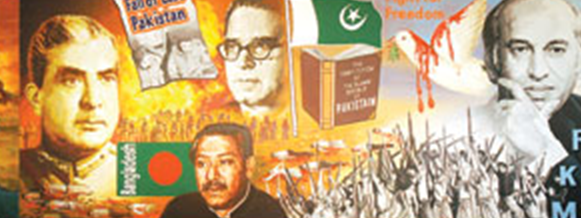Hoardings (billboards): South Asia
This is a collection of articles archived for the excellence of their content. Readers will be able to edit existing articles and post new articles directly |
Hoardings
Reinventing cinema hoardings
When CAP launched ‘Shanaakht: The Identity Project,’ a few days before 14th Aug 2007, at the Arts Council their purpose was to document the incredible experiences of the partition generation so that future Pakistanis could understand the roots of their identity. They brought history to life through tangible exhibits in varied genres among which the most accessible was the mural exhibit ‘Hamari Tareekh’. Cinema billboard artist S.Iqbal and Ajmal were called upon to create a series of six murals (from 1947 – 2007) each covering one decade of Pakistan’s history and popular culture. S. Iqbal has exhibited his works in Japan recently, and is the last cinema billboard artist to continue the tradition of hand painting his creations.
Documenting history through the garish billboard medium is a departure from the norm but Shalale who organised the mural project pointed out that the intention was to give the public “a different way of looking at Pakistani history.” The works were well received by the general public attending the festival, marking 60 years of independence, because the compositions placed in the relevant political context were so familiar — and considering the brassy and loud nature of cinema hoardings here, they were also executed with considerable finesse. Working with a dramatic but well controlled palette the murals were drawn and painted with confidence. Relocated into new compositions the memorable images were brought to life as important characters in the story of Pakistan. The first decade referenced Partition through the well known scene of the migatory kafila with refugees on foot and the bullock carts, strong images of the Quaid, Allama Iqbal and the Union Jack waving in the distance identified Lord Mountbatten while our Freedom Fighters and later political leaders like Khawaja Nazimuddin, I.I. Chundrigar, Iskander Mirza, Hussain Shaheed Suhrawardy etc. were suitably set against the ‘Sabz Parcham’. The artists handled the art of portraiture with considerable aplomb in all their murals inspite of anatomical mistakes. Particularly interesting to view were likenesses of other players in the politico social frame like Nur Jehan, Qadeer Khan etc. prominently placed against the events they represented. Appropriate architectural and scenic inserts were also used to illustrate history.
In many instances it is necessary to speak to the unprofessional audience in a popular way. From flashy cinema hoardings publicising C grade cinema to educational lessons in history these mural painters have shown their versatility in billboard art. Organisers at CAP have introduced a new trend — reinventing the content of billboard art to capture public attention not for advertising but for enlightenment and storytelling. This is a development that can be used to advantage for purposes of instruction and teaching in mass communication. A billboard can never be obscure. It is a means of instant contact. To achieve this immediate attention the designer, like an entertainer works with his audience by opting for a popular idiom, one that has mass appeal – For a large segment of the common public attending the Shanaakth festival CAP was able to present the salient features of our 60 year history in a palatable format.— S. A

